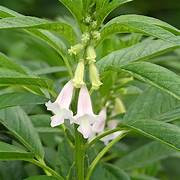Phytochemical and In vitro Antifungal Evaluation of Some Selected Leaf Extracts against Fungi Associated with Sesamum indicium (seeds) Spoilage within Dekina Local Government Area, Kogi East, Nigeria: A Molecular Approach http://www.doi.org/10.26538/tjnpr/v7i12.44
Main Article Content
Abstract
Sesame (Sesamum indicum L.) is one of Nigeria's most important oil crops, effective storage is still a leading problem with the preservation of sesame. Fungal infestation of sesame is a major cause of spoilage. The present study aimed to evaluate the potential biocontrol agents of some selected plant extracts (Cymbogogon citratus, Moringa oleifera, Azadirachta indica (Neem), and Reuwolfiea vomitoria) against four sesame seed spoilage heterotrophic fungi (Fusarium monoliforme, Aspergillus flavus, Alternaria sesame, and Penicillium sp.). Infected seed samples of sesame were collected from different sesame farms within Dekina local government and its environs to isolate fungal pathogens. The in-vitro potential of the tested plant extracts was evaluated against four isolates of phytopathogenic heterotrophic fungi in an agar well diffusion method. A total of 281 heterotrophic fungi were isolated. Alternaria sesame (number of isolate (n) = 91) had the highest distribution, while Fusarium monoliforme had the lowest distribution (n = 19). Extract concentration was impassively proportional to antifungal activity across all the fungal isolates at P<0.005. The antifungal activity of some selected extracts Cymbogogon citratus, Moringa oleifera, Azadirachta indica (Neem), and Reuwolfiea vomitoria) on the fungal isolates associated with sesame seed within Kogi East and its environs showed moderate antifungal activity (mycelium growth between 20 -60% across all test isolates). It thus offers a choice alternative in the preservation and processing of sesame seed within the region and the country.
Downloads
Article Details

This work is licensed under a Creative Commons Attribution-NonCommercial-NoDerivatives 4.0 International License.
References
Jyothi B, Ansari NA, Vijay Y, Anuradha G, Sarkar A. Sudhakar, R. and Siddiq, E.A. Assessment of resistance to Fusarium wilt disease in sesame (Sesamumindicum L.) germplasm. Aus. Plnt. pathol. 2011(40):471–475.
Falusi AO and Salako EA. Assemblage of sesame germplasm for conservation and genetic improvement in Nigeria. Plant Genet. Resources Newsletter. 2001(127):25 – 38.
Chakraborthy GS, Sharma G, Kaushik KN. Sesamumindicum: A review. J Herb. Med. Toxicol. 2008;2(2):15 – 19.
Singh PK, Akram M, Vajpeyi M, Srivastava RL, Kumar K, Naresh R. Screening and development of resistant sesame varieties against phytoplasma. Bull. Insectol. 2007;60 (2): 303-304.
Sulieman MN, and Alege G.O. Fungi associated with beniseed (Sesamumindicum L.) from ten different locations in Nigeria. Nig. J. Bot. 2013;26(2): 161-166.
Nasir A, Sahid AK, Mushtaq A, Rehuna AR, Ashfaq M. Seed borne mycoflora of sesame (sesamumindicum L) and their effect on germination and seeding growth, Pak. J. Bio. Sci. 2004; 7 (2): 243-245.
Yusuf M, Akowe II, Beida AS, Iyaji J, Abdulhakeem S, Alao AO. Response of sesame to different Nutrient sources in Anyigba, Kogi State. Proceeding of the 2nd ICAAT conference 20222. 2022:680-691.
Borokini T, and Omotayo FI. Phytochemical and ethnobotanical study of some selected medicinal plants from Nigeria. J. Med. Plnt. Res. 2012; 9(6) 56-67. DOI:10.5897/JMPR09.430
Adebisi MA. Variation stability and correlation studies in seed quality and yield components of sesame (Sesamumindicum L). Ph.D. Agric. Thesis. University of Agriculture, Abeokuta, 2005: Nigeria 85p.
Adebisi M.A, Ajala MO, Ojo DK, and Salau AW. Influence of population density and season on seed yield and its components in Nigerian sesame genotypes. J. Trop. Agric. 2005;43 (1- 2): 13 – 18.
Borchani C, Besbes S, Blecker CH, and Attia H. Chemical Characteristics and Oxidative Stability of Sesame Seed, Sesame Paste, and Olive Oils. J. Agric. Sci & Tech, 2010;(12): 585-596.
Sazada SY, Ruchi Y, Kavita AW, Feroze KM, Mukesh S, Sudarshana J, and Farah J. Allelopathic potentialities of different concentration of aqueous leaf extracts of some arable trees on germina on and rad le growth of Cicer arietinum Var.-C-235. Glbal. J. Mol. Sci;2016;4(2): 91-95.
Win MM. Phenolic compounds and antioxidant activity of peanut's skin, hull, raw kernel and roasted kernel flour. Pak. J. Bot., 2011;43 (3):1635-1642.
Adejumobi JA, Ogundiya MO, Kolapo AL, Okunade MB. Phytochemical composition and in vitro antimicrobial activity of Anogeissusleiocarpus on some common oral pathogens. J Med Plants Res 2009;4(4), 471-475.


